Estimation Technique for IGBT Module Junction Temperature in a High-Power Density Inverter
Abstract
:1. Introduction
2. Three-Phase Traction Inverter with Parallel IGBT Modules
3. IGBT Module’s Loss Components and Calculation Techniques
3.1. IGBT Module’s Loss Components
3.2. Analytical Calculation Using the Datasheet Characteristics
3.2.1. Conduction Losses Calculation
3.2.2. Switching Losses Calculation
- The first is the transistor switching losses, which occur during the transition between the on-state and off-state of the transistor and contain the turn-on losses (Psw_onT) and the turn-off losses (Psw_offT).
- The second component is the diode reverse recovery loss (Prr_D) which also depend on the reverse recovery energy (ErcD) of the diode and can be expressed as:
3.3. Simulation Estimation Using the Module Rating Information
3.4. IGBT Module Power Losses Calculation Results and Comparison
4. IGBT Module Heat Pipe System Design Technique
5. IGBT Module Thermal Modelling and Analysis
5.1. IGBT Module’s Structure and Material Study
5.2. IGBT Module Geometry Clean-Up
5.3. Boundary Conditions Setup
6. FEM Thermal Analysis Results and Discussion
- The ability to apply for the estimation of the temperature range for any IGBT module, with any loading condition using simple calculations of the module power losses and thermal model analysis.
- Offers the ability to confirm the appropriate selection of the IGBT module for the target application before the manufacturing process.
- Saving the time and money required for the testing process to check the module junction temperature as compared with the other experimental setup techniques.
- Temperature measurements with high accuracy since no ideal components and no assumptions (datasheet parameters and the actual model performance are used in the analysis) are used in the analysis which offers the results closet to the practical reality.
7. Conclusions and Future Work
Author Contributions
Funding
Data Availability Statement
Conflicts of Interest
References
- Abuelnaga, A.; Narimani, M.; Bahman, A.S. A review on IGBT module failure modes and lifetime testing. IEEE Access 2021, 9, 9643–9663. [Google Scholar] [CrossRef]
- Xiao, D. On Modern IGBT Modules: Characterization, Reliability and Failure Mechanisms. Master’s Thesis, Institutt for elkraftteknikk, Trondheim, Norway, 2010. [Google Scholar]
- Abuelnaga, A.; Narimani, M.; Bahman, A.S. Power electronic converter reliability and prognosis review focusing on power switch module failures. J. Power Electron. 2021, 21, 865–880. [Google Scholar] [CrossRef]
- Suh, I.W.; Jung, H.S.; Lee, Y.H.; Choa, S.H. Numerical prediction of solder fatigue life in a high power IGBT module using ribbon bonding. J. Power Electron. 2016, 16, 1843–1850. [Google Scholar] [CrossRef]
- Peyghami, S.; Blaabjerg, F.; Palensky, P. Incorporating power electronic converters reliability into modern power system reliability analysis. IEEE J. Emerg. Sel. Top. Power Electron. 2020, 9, 1668–1681. [Google Scholar] [CrossRef]
- Haque, M.S.; Moniruzzaman, M.; Choi, S.; Kwak, S.; Okilly, A.H.; Baek, J. A Fast Loss Model for Cascode GaN-FETs and Real-Time Degradation-Sensitive Control of Solid-State Transformers. Sensors 2023, 23, 4395. [Google Scholar] [CrossRef] [PubMed]
- Ciappa, M. Selected failure mechanisms of modern power modules. Microelectron. Reliab. 2002, 42, 653–667. [Google Scholar] [CrossRef]
- Choi, U.M.; Blaabjerg, F.; Lee, K.B. Study and handling methods of power IGBT module failures in power electronic converter systems. IEEE Trans. Power Electron. 2014, 30, 2517–2533. [Google Scholar] [CrossRef]
- Lu, Y.; Christou, A. Prognostics of IGBT modules based on the approach of particle filtering. Microelectron. Reliab. 2019, 92, 96–105. [Google Scholar] [CrossRef]
- Kumar, D.; Nema, R.K.; Gupta, S. Development of a novel fault-tolerant reduced device count T-type multilevel inverter topology. Int. J. Electr. Power Energy Syst. 2021, 132, 107185. [Google Scholar] [CrossRef]
- Yang, S.; Bryant, A.; Mawby, P.; Xiang, D.; Ran, L.; Tavner, P. An industry-based survey of reliability in power electronic converters. IEEE Trans. Ind. Appl. 2011, 47, 1441–1451. [Google Scholar] [CrossRef]
- Li, L.; He, Y.; Wang, L.; Wang, C.; Liu, X. IGBT lifetime model considering composite failure modes. Mater. Sci. Semicond. Process. 2022, 143, 106529. [Google Scholar] [CrossRef]
- Chen, J.; Yang, Z.G. Failure analysis on the premature delamination in the power module of the inverter for new energy vehicles. Eng. Fail. Anal. 2023, 143, 106915. [Google Scholar] [CrossRef]
- Cheng, Y.; Fu, G.; Jiang, M.; Xue, P. Investigation on intermittent life testing program for IGBT. J. Power Electron. 2017, 17, 811–820. [Google Scholar] [CrossRef]
- Sarkany, Z.; Rencz, M. Methods for the Separation of Failure Modes in Power-Cycling Tests of High-Power Transistor Modules Using Accurate Voltage Monitoring. Energies 2020, 13, 2718. [Google Scholar] [CrossRef]
- Hernes, M.; D’Arco, S.; Antonopoulos, A.; Peftitsis, D. Failure analysis and lifetime assessment of IGBT power modules at low temperature stress cycles. IET Power Electron. 2021, 14, 1271–1283. [Google Scholar] [CrossRef]
- Sathik, M.H.; Sundararajan, P.; Sasongko, F.; Pou, J.; Natarajan, S. Comparative analysis of IGBT parameters variation under different accelerated aging tests. IEEE Trans. Electron. Devices 2020, 67, 1098–1105. [Google Scholar] [CrossRef]
- Hu, Z.; Du, M.; Wei, K. Real-time monitoring solder fatigue for IGBT modules using case temperatures. HKIE Trans. 2017, 24, 141–150. [Google Scholar] [CrossRef]
- Gao, T.; Ding, L.; Wang, J.; Chen, W.; Fan, X. Analysis of Blocking Capability Failure Mechanism in IGBT Module under High Salt Spray Environment. IEEE Trans. Dielectr. Electr. Insul. 2023. [Google Scholar] [CrossRef]
- Ma, Y.; Li, J.; Dong, F.; Yu, J. Power cycling failure analysis of double side cooled IGBT modules for automotive applications. Microelectron. Reliab. 2021, 124, 114282. [Google Scholar] [CrossRef]
- Eleffendi, M.A.; Yang, L.; Agyakwa, P.; Johnson, C.M. Quantification of cracked area in thermal path of high-power multi-chip modules using transient thermal impedance measurement. Microelectron. Reliab. 2016, 59, 73–83. [Google Scholar] [CrossRef]
- Li, W.; Li, G.; Sun, Z.; Wang, Q. Real-time estimation of junction temperature in IGBT inverter with a simple parameterized power loss model. Microelectron. Reliab. 2021, 127, 114409. [Google Scholar] [CrossRef]
- Shahjalal, M.; Shams, T.; Hossain, S.B.; Ahmed, M.R.; Ahsan, M.; Haider, J.; Goswami, R.; Alam, S.B.; Iqbal, A. Thermal analysis of Si-IGBT based power electronic modules in 50kW traction inverter application. e-Prime-Adv. Electr. Eng. Electron. Energy 2023, 3, 100112. [Google Scholar] [CrossRef]
- Qian, C.; Gheitaghy, A.M.; Fan, J.; Tang, H.; Sun, B.; Ye, H.; Zhang, G. Thermal management on IGBT power electronic devices and modules. IEEE Access 2018, 6, 12868–12884. [Google Scholar] [CrossRef]
- Yang, Y.; Zhang, Q.; Zhang, P. A fast IGBT junction temperature estimation approach based on ON-state voltage drop. IEEE Trans. Ind. Appl. 2020, 57, 685–693. [Google Scholar] [CrossRef]
- Ma, M.; Yan, X.; Guo, W.; Yang, S.; Cai, G.; Chen, W. Online junction temperature estimation using integrated NTC thermistor in IGBT modules for PMSM drives. Microelectron. Reliab. 2020, 114, 113836. [Google Scholar] [CrossRef]
- Bahman, A.S.; Ma, K.; Ghimire, P.; Iannuzzo, F.; Blaabjerg, F. A 3-D-lumped thermal network model for long-term load profiles analysis in high-power IGBT modules. IEEE J. Emerg. Sel. Top. Power Electron. 2016, 4, 1050–1063. [Google Scholar] [CrossRef]
- Cao, H.; Ning, P.; Chai, X.; Zheng, D.; Kang, Y.; Wen, X. Online monitoring of IGBT junction temperature based on V ce measurement. J. Power Electron. 2021, 21, 451–463. [Google Scholar] [CrossRef]
- Xu, Z.; Xu, F.; Wang, F. Junction Temperature Measurement of IGBTs Using Short-Circuit Current as a Temperature-Sensitive Electrical Parameter for Converter Prototype Evaluation. IEEE Trans. Ind. Electron. 2015, 62, 3419–3429. [Google Scholar] [CrossRef]
- Zhang, Z.; Dyer, J.; Wu, X.; Wang, F.; Costinett, D.; Tolbert, L.M.; Blalock, B.J. Online Junction Temperature Monitoring Using Intelligent Gate Drive for SiC Power Devices. IEEE Trans. Power Electron. 2019, 34, 7922–7932. [Google Scholar] [CrossRef]
- Lim, H.; Hwang, J.; Kwon, S.; Baek, H.; Uhm, J.; Lee, G. A study on real time IGBT junction temperature estimation using the NTC and calculation of power losses in the automotive inverter system. Sensors 2021, 21, 2454. [Google Scholar] [CrossRef]
- Zhu, Y.; Xiao, M.; Su, X.; Yang, G.; Lu, K.; Wu, Z. Modeling of conduction and switching losses for IGBT and FWD based on SVPWM in automobile electric drives. Appl. Sci. 2020, 10, 4539. [Google Scholar] [CrossRef]
- FZ1200R33KF2C—Module Datasheet Technical Information, Infineon. Available online: https://datasheetspdf.com/pdf-file/1439925/Infineon/FZ1200R33KF2C/1 (accessed on 20 February 2023).
- Arrozy, J.; Retianza, D.V.; Duarte, J.L.; Ilhan Caarls, E.; Huisman, H. Influence of Dead-Time on the Input Current Ripple of Three-Phase Voltage Source Inverter. Energies 2023, 16, 688. [Google Scholar] [CrossRef]
- Yang, Y.; Wen, H.; Li, D. A fast and fixed switching frequency model predictive control with delay compensation for three-phase inverters. IEEE Access 2017, 5, 17904–17913. [Google Scholar] [CrossRef]
- Aboelsaud, R.; Ibrahim, A.; Garganeev, A.G.; Aleksandrov, I.V. Improved dead-time elimination method for three-phase power inverters. Int. J. Power Electron. Drive Syst. 2020, 11, 1759–1766. [Google Scholar] [CrossRef]
- Yunus, A.C. Heat Transfer: A Practical Approach; MacGraw Hill: New York, NY, USA, 2003; p. 210. [Google Scholar]


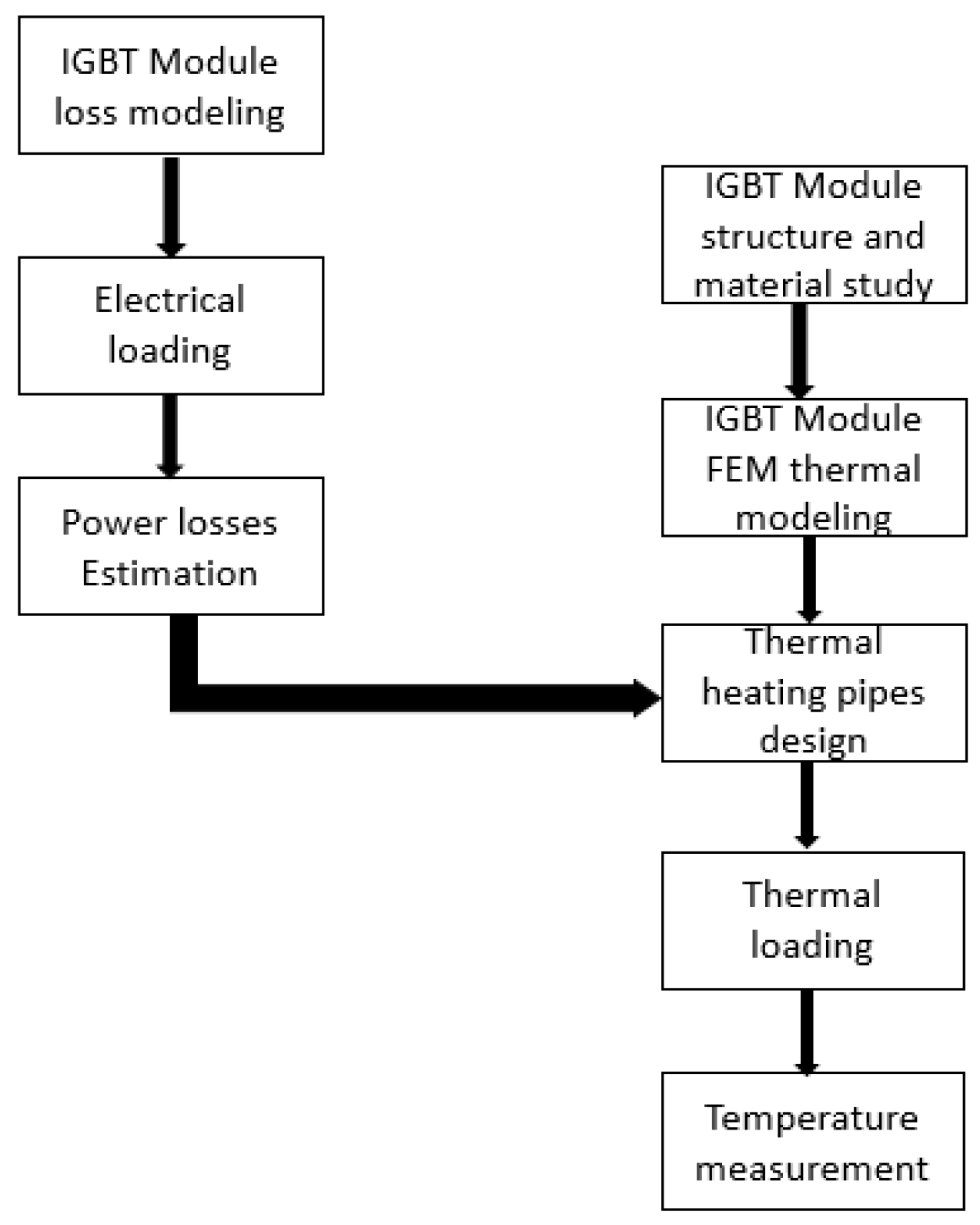


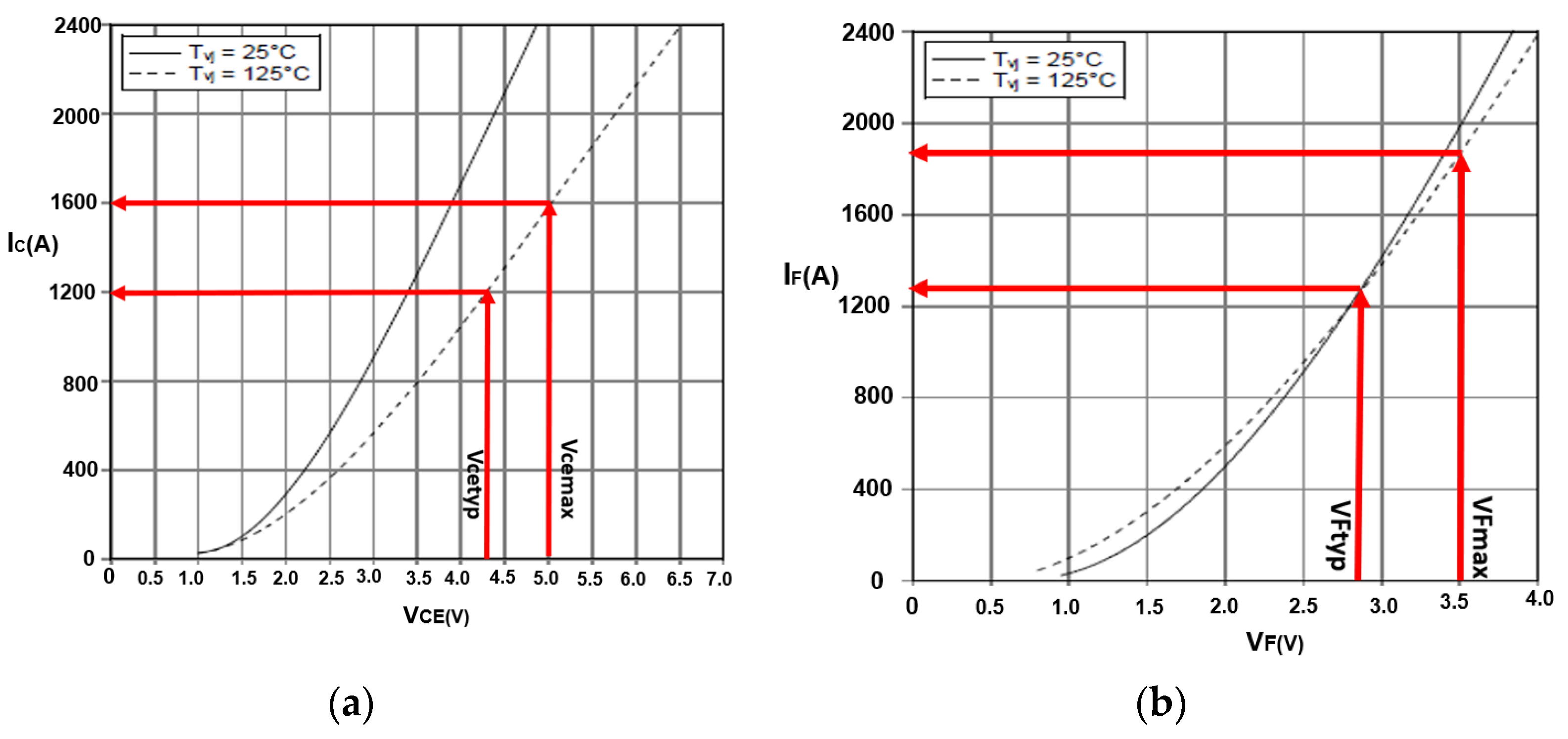

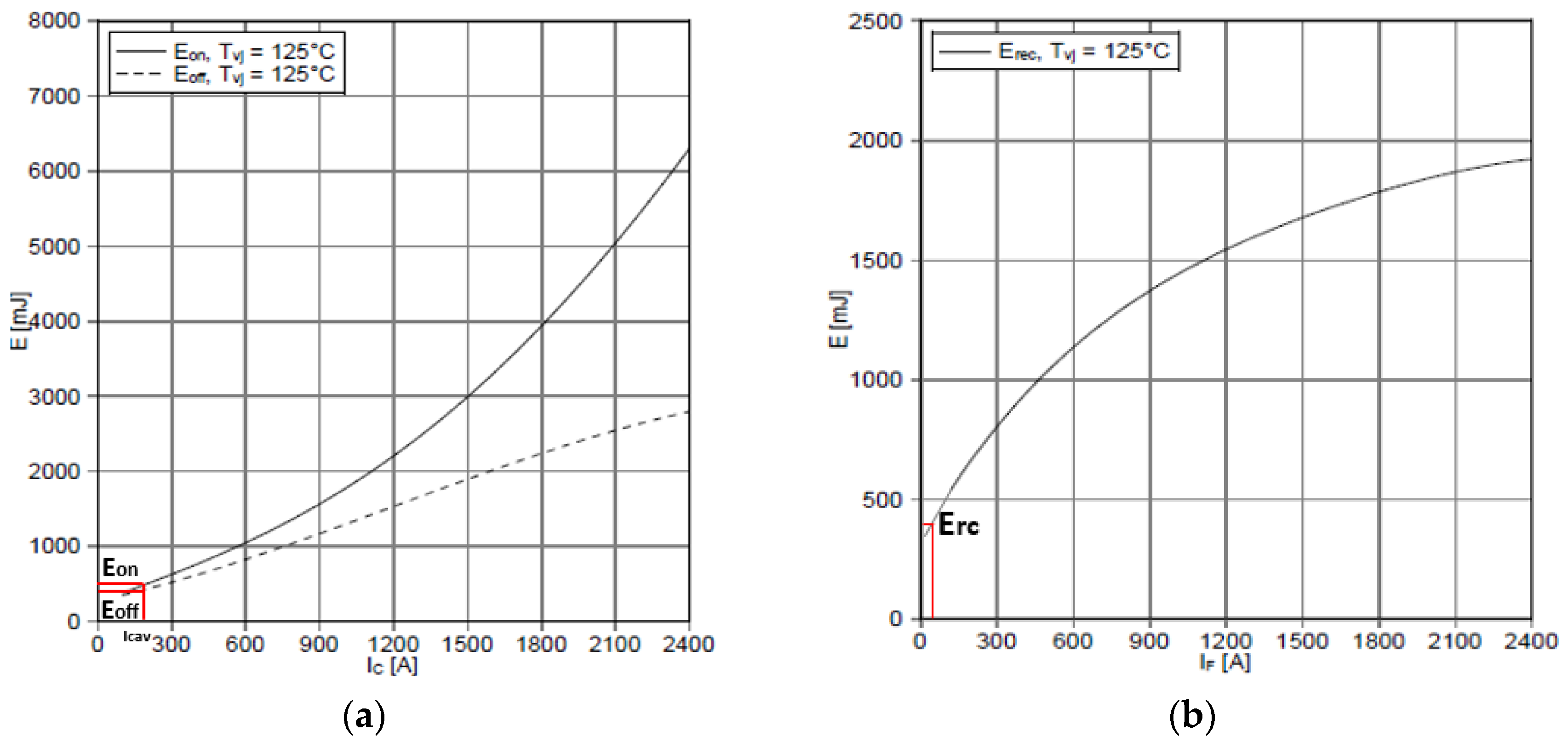
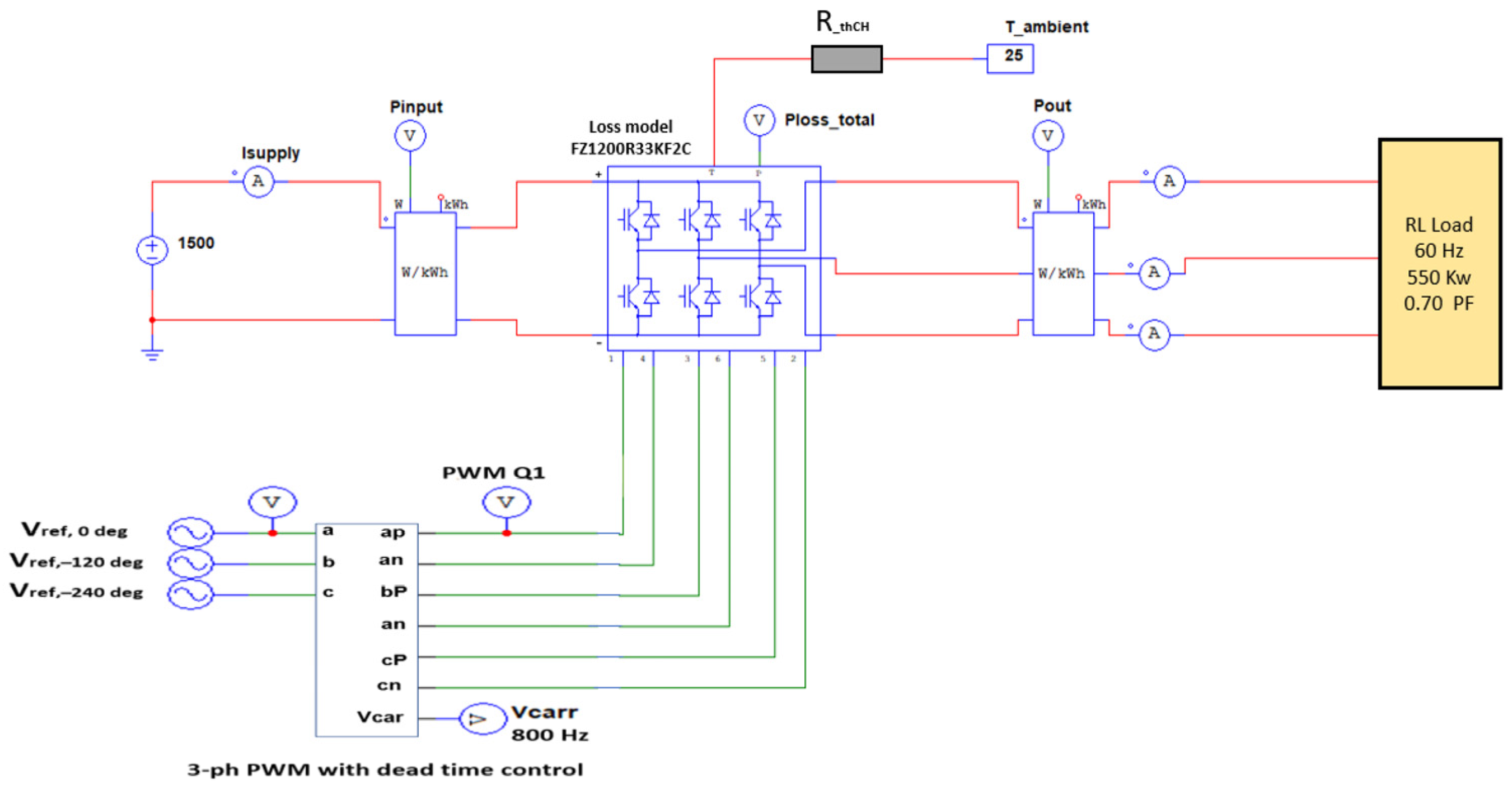


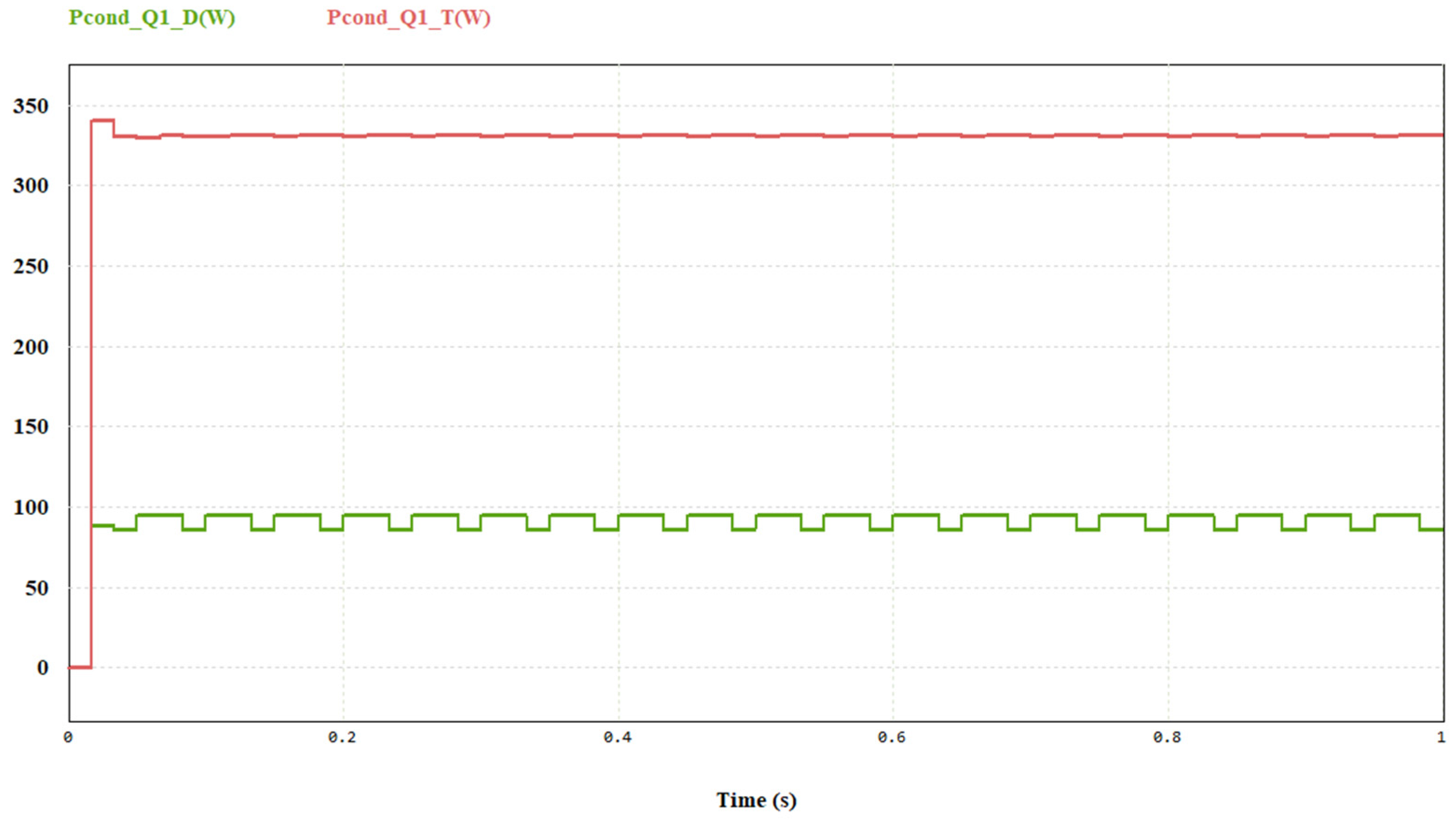
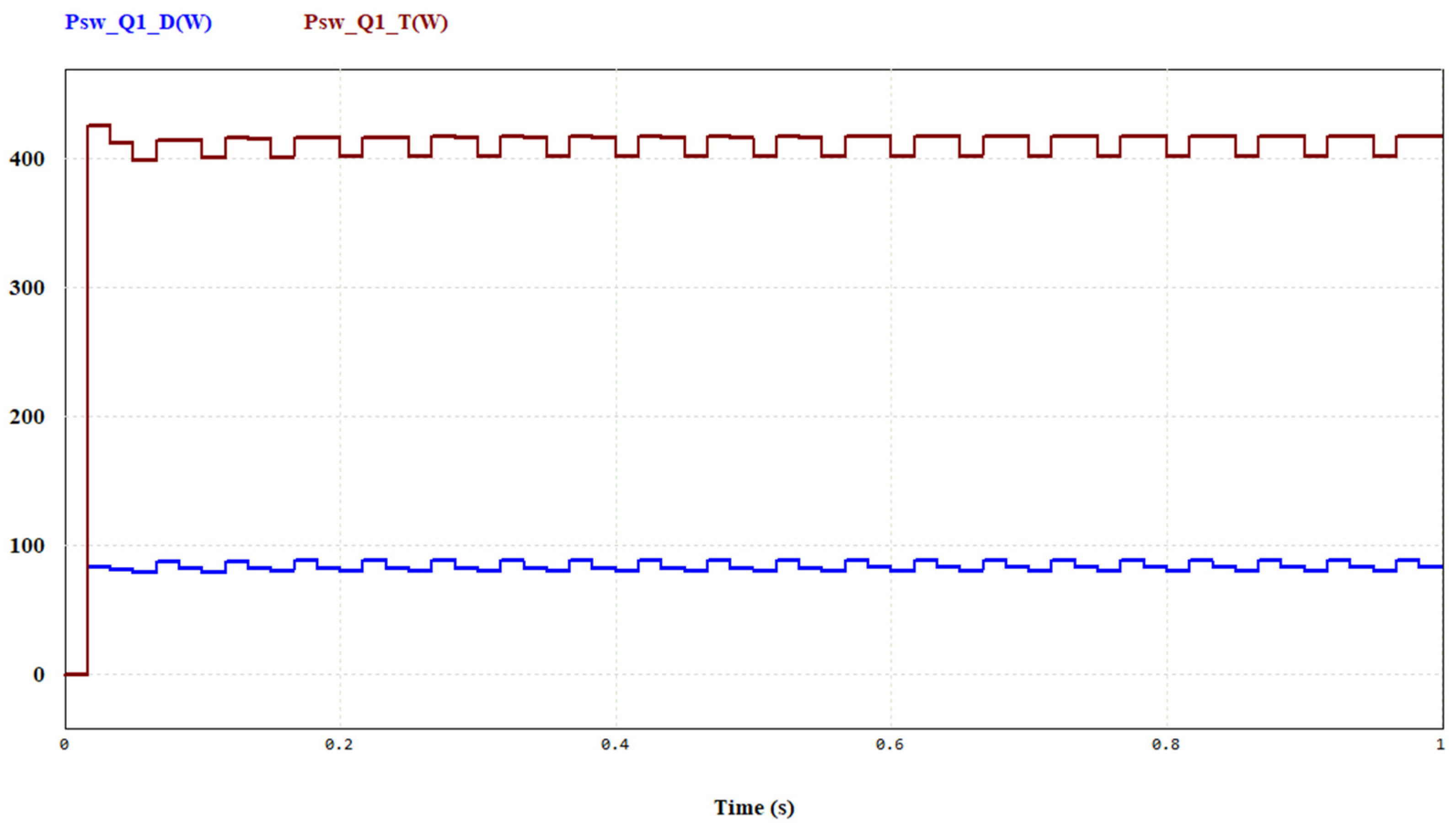
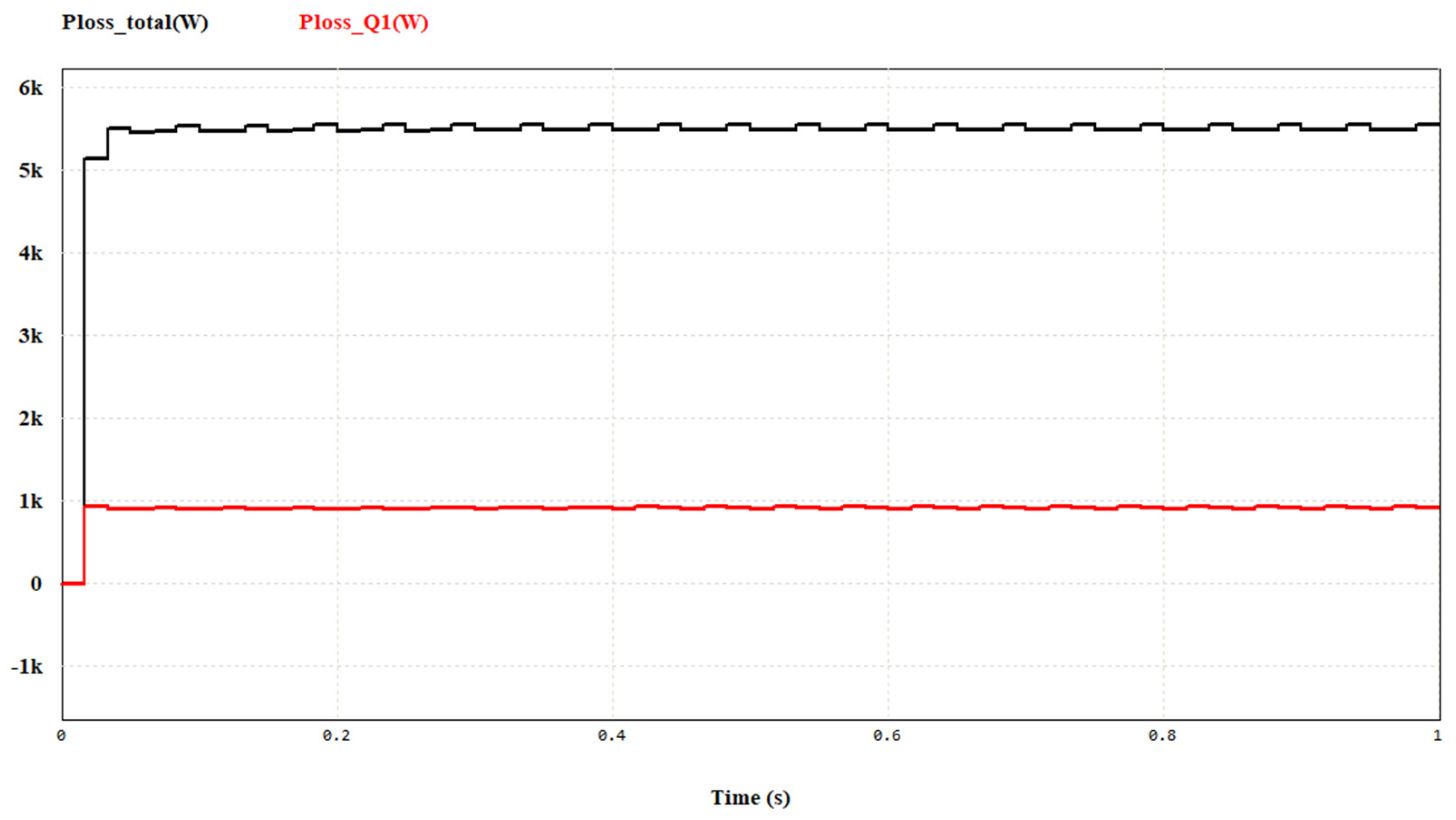
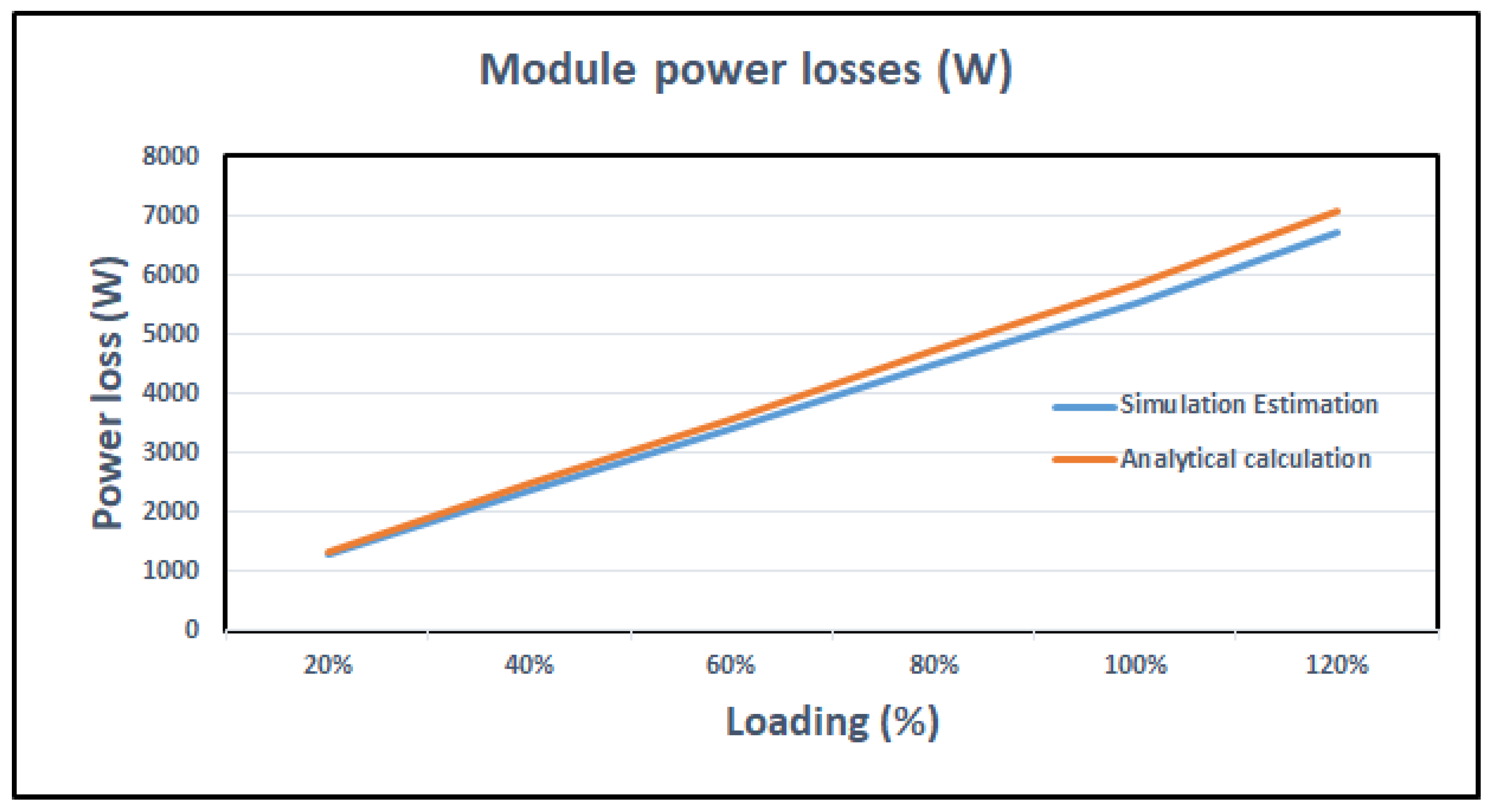
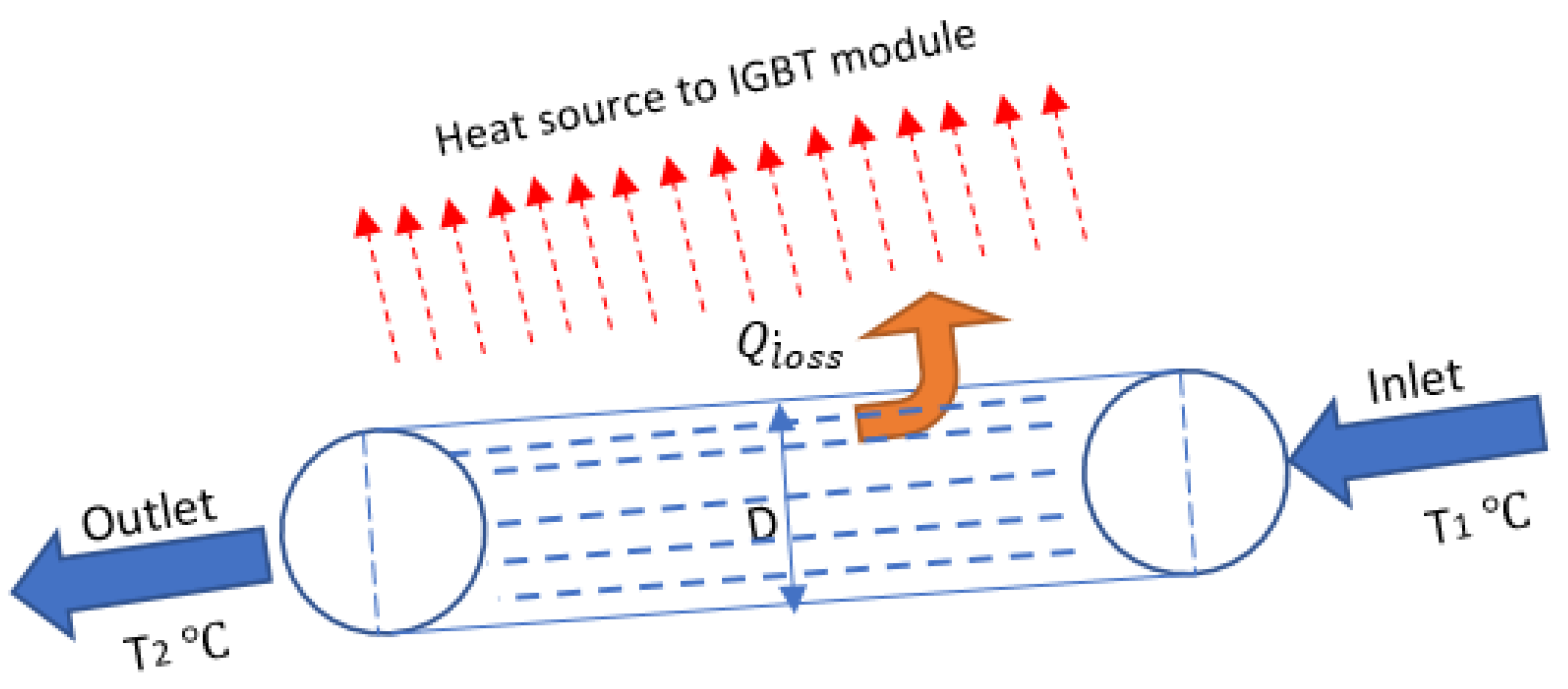

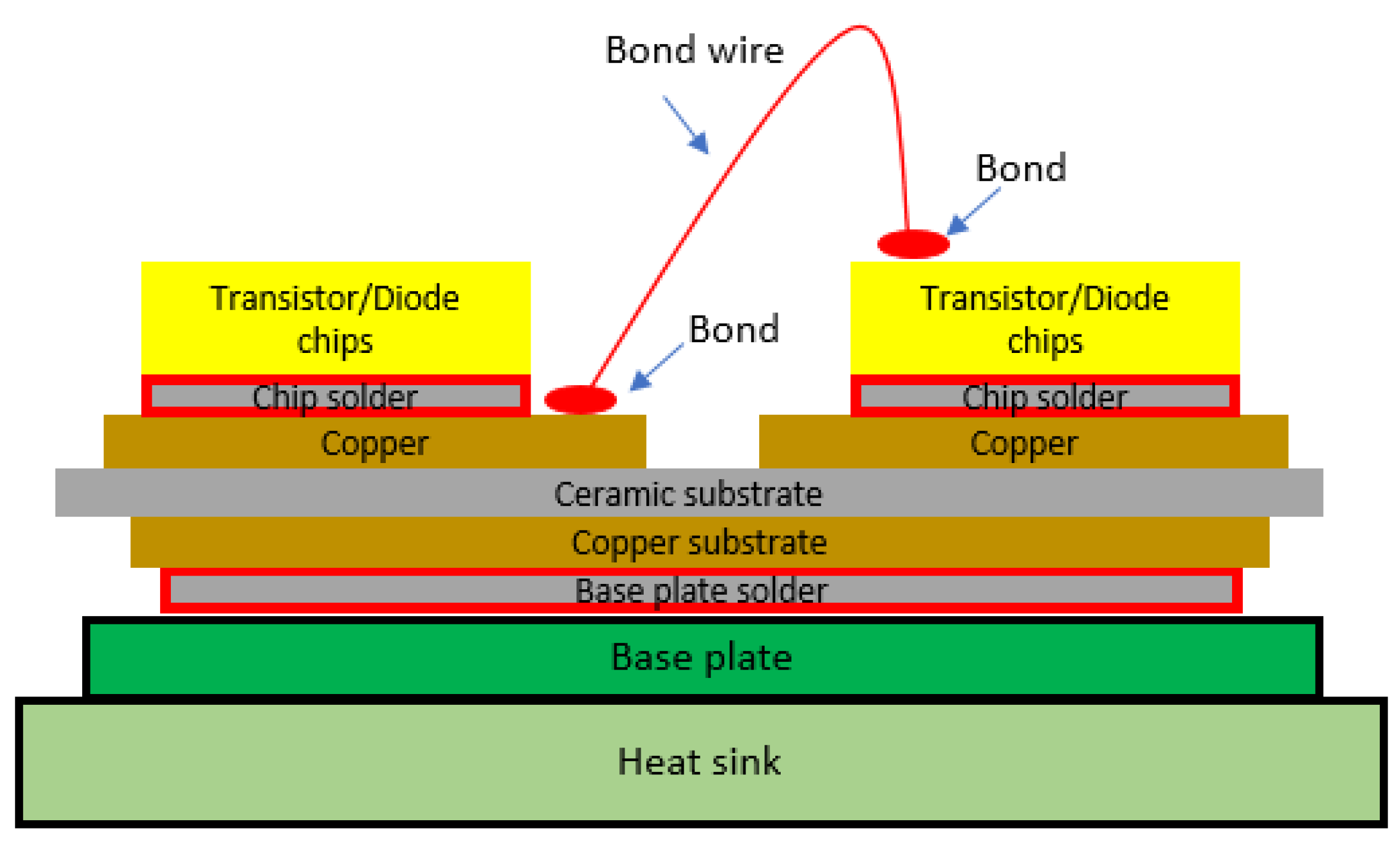






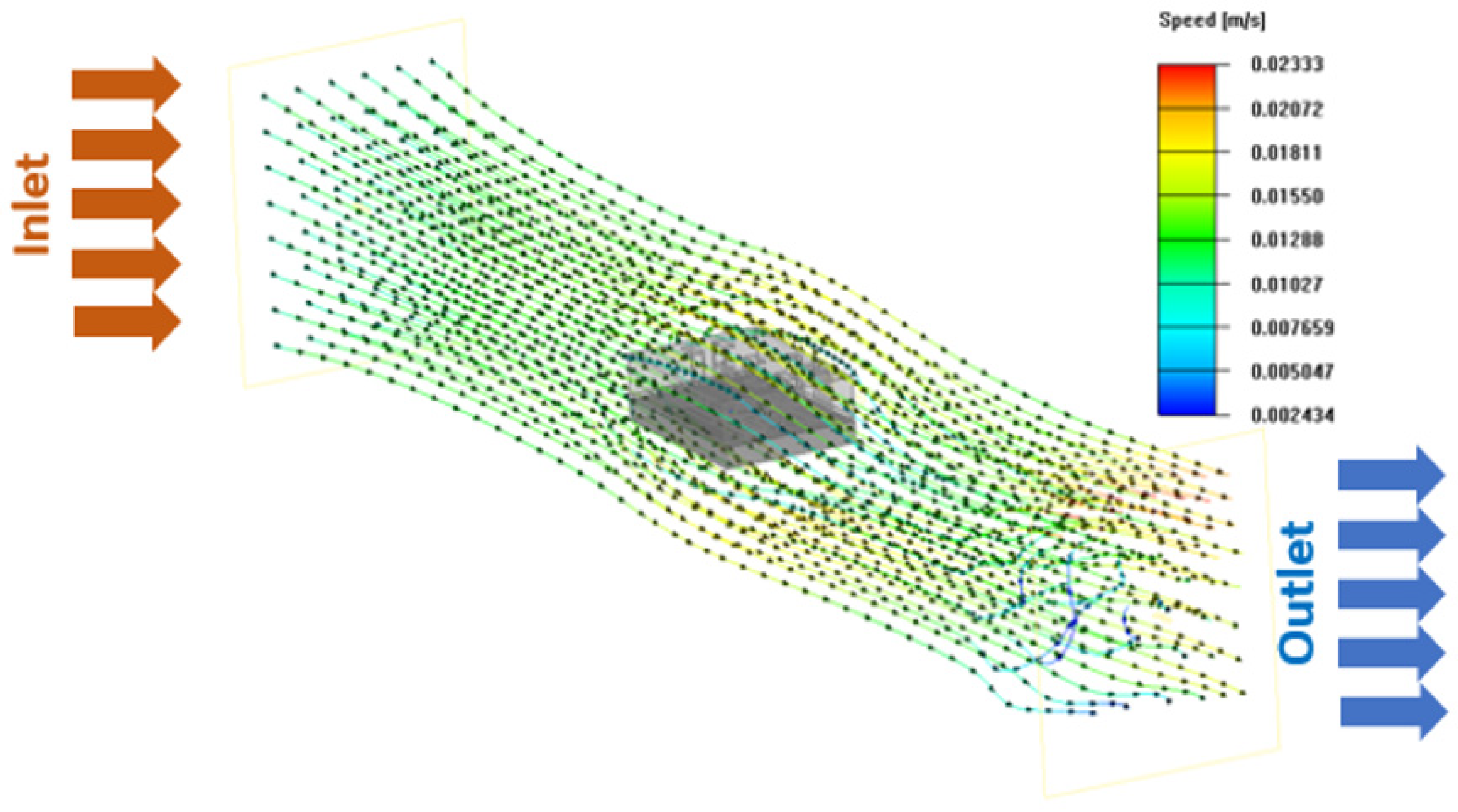
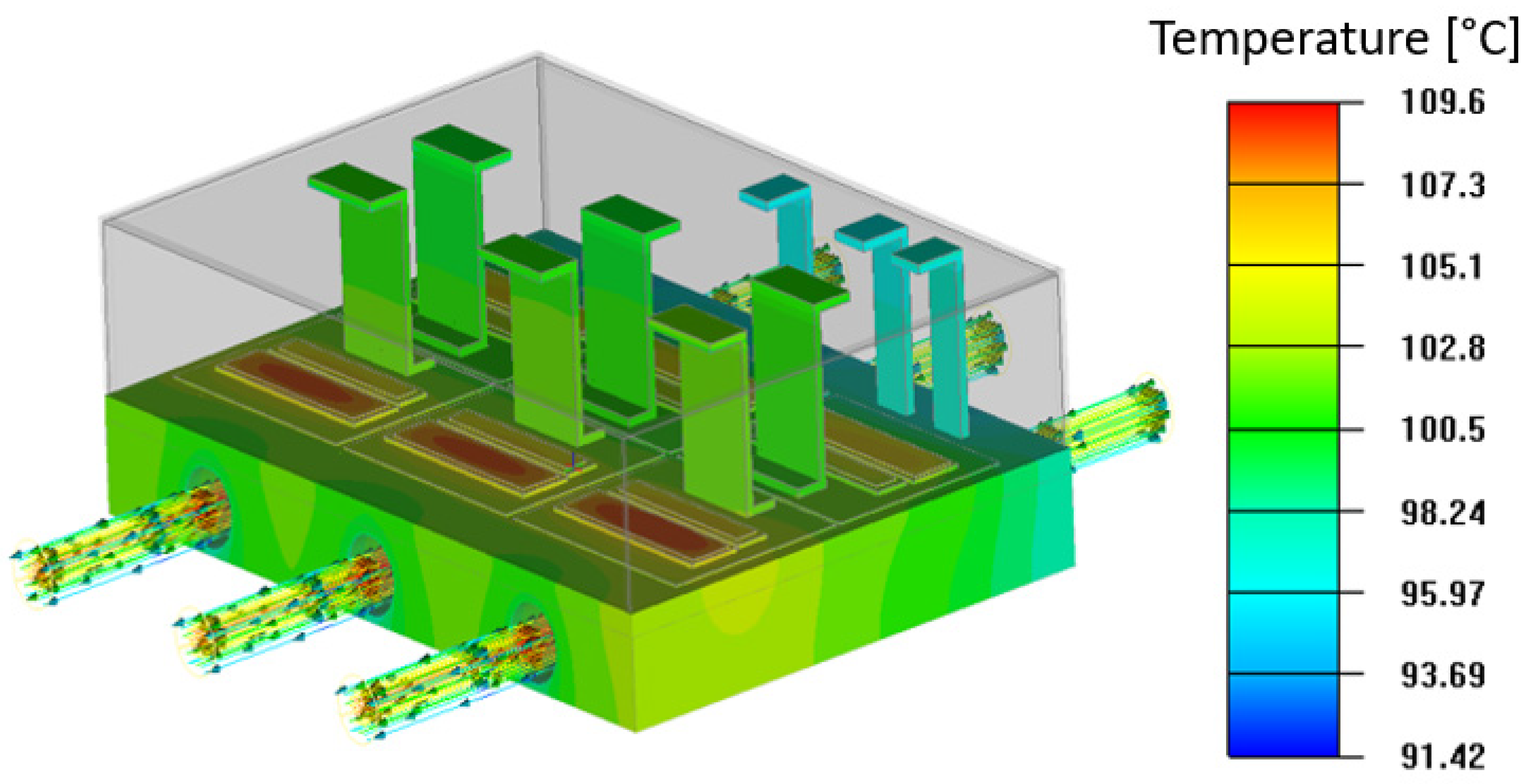
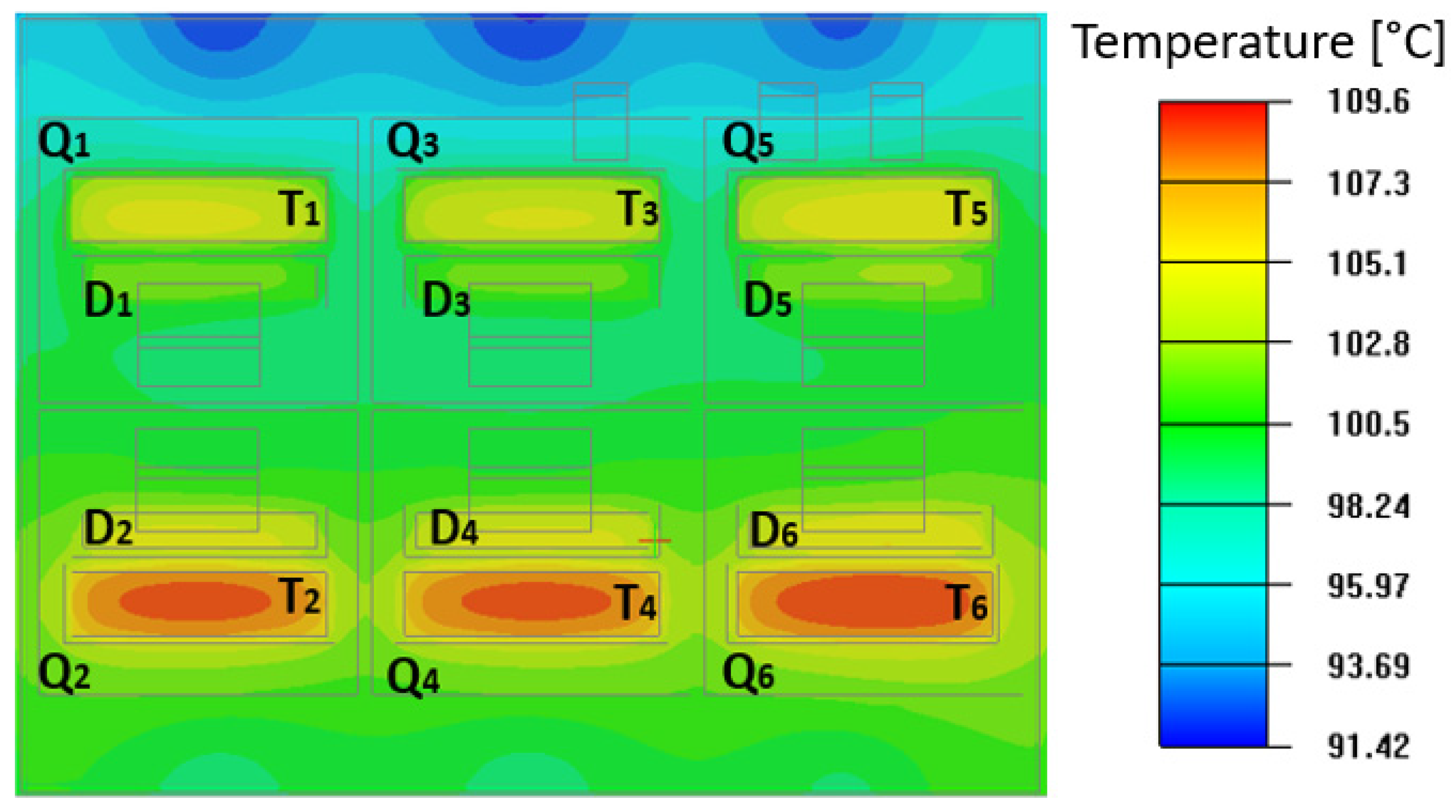
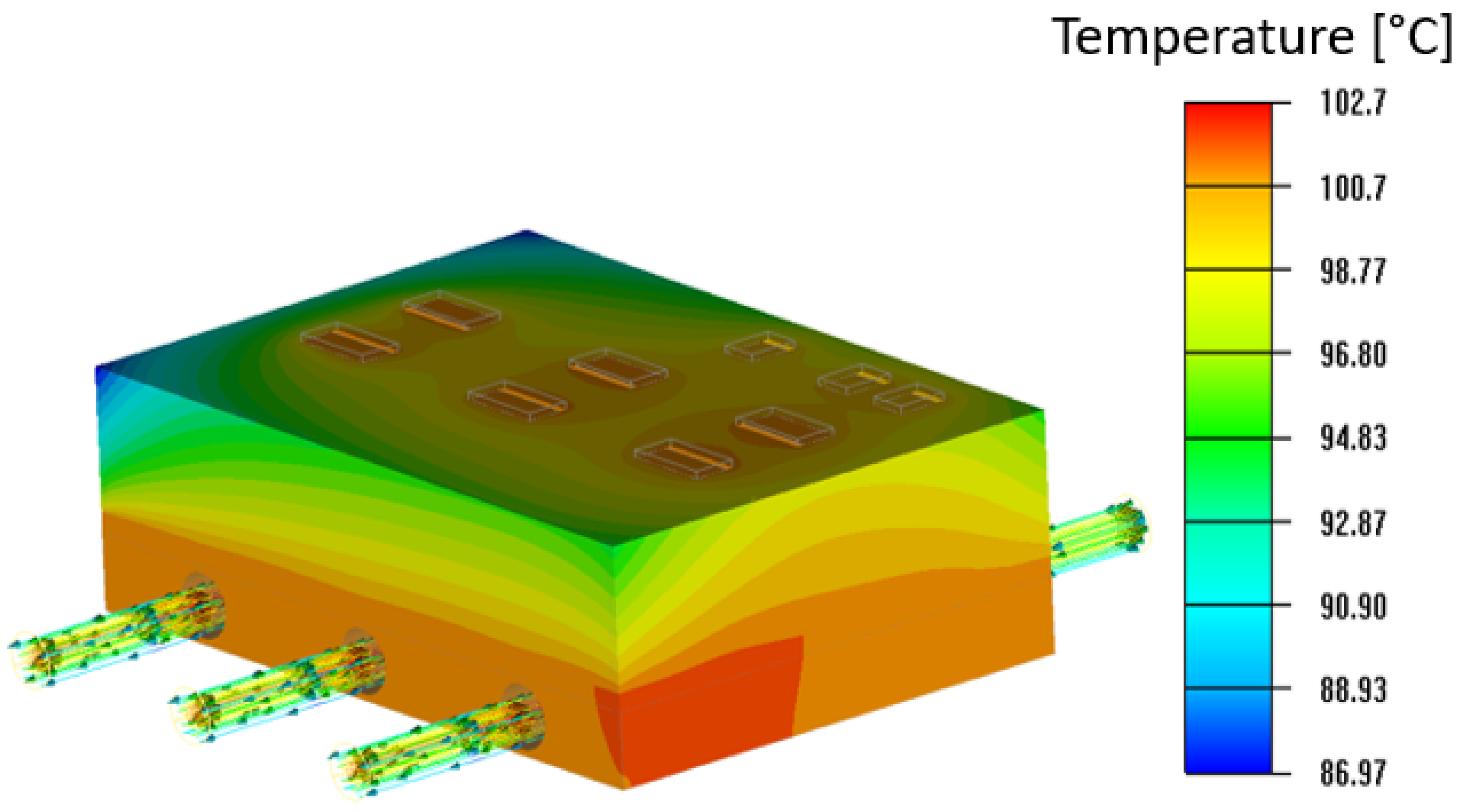
| Parameter | Value |
|---|---|
| Rated output power (Po) | 550 kW |
| Load power factor (PF) | 0.70 |
| Input DC voltage (Vin) | 1500 V |
| Output load current (Io) | 500 Arms |
| Load frequency (f) | 60 Hz |
| Switching frequency (Fsw) | 800 Hz |
| IGBT module part number | FZ1200R33KF2C |
| Target Max. junction temperature (Tjmax) | 125 °C |
| Losses Term | Average Value (W) | Mismatch% | |
|---|---|---|---|
| Analytical | Simulation | ||
| Pcond_Q1_D | 86.5 | 91.97 | 6.30 |
| Pcond_Q1_T | 352.3 | 331.40 | 5.90 |
| Psw_Q1_D | 91 | 84.06 | 7.60 |
| Psw_Q1_T | 445.67 | 412.08 | 7.50 |
| Ploss_Q1 | 975.67 | 919.51 | 5.75 |
| Part | Transistor Chip | Diode Chip | Ceramic Substrate | Copper Substrate | Base Plate | Bus Bar | Housing | Heat Sink | Silicon Fill |
|---|---|---|---|---|---|---|---|---|---|
| Material | Si | Si | Si3N4 | Cu | AlSiC | Cu | Plastic | Al | - |
| Density (Kg/m3) | 2330 | 2330 | 3200 | 8933 | 2960 | 8933 | 1150 | 2700 | - |
| Specific heat (J/Kg-k) | 710 | 710 | 695 | 397 | 740 | 397 | 1600 | 937 | - |
| Conductivity (W/m-k) | 148 | 148 | 80 | 387.4 | 200 | 387.4 | 0.25 | 240 | 0.2 |
| Boundary Condition | External Boundary Condition | Internal Boundary Condition |
|---|---|---|
| Inlet | Air flow = 0.01 m/s | Water flow = 0.07 m/s |
| Outlet | Opening | Opening |
| Wall | Adiabatic | - |
| Water temperature | - | 60 °C |
| Condition | Value |
|---|---|
| Ambient temperature | 25 °C |
| Variables solved | Flow (water, air), Temperature |
| Analysis time | Steady-State |
| Number of iterations | 100 |
| Flow model | Laminar |
| Air flow | Force convection |
| Generated Mesh | About 5 million used |
| Operating pressure | 1.013 × 105 N/m2 |
| Semiconductor Part | Temp. with Housing (°C) | Temp. without Housing (°C) | |
|---|---|---|---|
| Switch Q1 | T1 | 105.52 | 99.35 |
| D1 | 102.27 | 97.20 | |
| Switch Q2 | T2 | 109.62 | 102.75 |
| D2 | 105.25 | 99.10 | |
| Switch Q3 | T3 | 105.12 | 99.15 |
| D3 | 101.91 | 97.25 | |
| Switch Q4 | T4 | 109.23 | 102.55 |
| D4 | 104.85 | 99.05 | |
| Switch Q5 | T5 | 105.80 | 99.55 |
| D5 | 102.55 | 97.45 | |
| Switch Q6 | T6 | 109.40 | 102.60 |
| D6 | 105.02 | 99.10 | |
Disclaimer/Publisher’s Note: The statements, opinions and data contained in all publications are solely those of the individual author(s) and contributor(s) and not of MDPI and/or the editor(s). MDPI and/or the editor(s) disclaim responsibility for any injury to people or property resulting from any ideas, methods, instructions or products referred to in the content. |
© 2023 by the authors. Licensee MDPI, Basel, Switzerland. This article is an open access article distributed under the terms and conditions of the Creative Commons Attribution (CC BY) license (https://creativecommons.org/licenses/by/4.0/).
Share and Cite
Okilly, A.H.; Choi, S.; Kwak, S.; Kim, N.; Lee, J.; Moon, H.; Baek, J. Estimation Technique for IGBT Module Junction Temperature in a High-Power Density Inverter. Machines 2023, 11, 990. https://doi.org/10.3390/machines11110990
Okilly AH, Choi S, Kwak S, Kim N, Lee J, Moon H, Baek J. Estimation Technique for IGBT Module Junction Temperature in a High-Power Density Inverter. Machines. 2023; 11(11):990. https://doi.org/10.3390/machines11110990
Chicago/Turabian StyleOkilly, Ahmed H., Seungdeog Choi, Sangshin Kwak, Namhun Kim, Jonghyuk Lee, Hyoungjun Moon, and Jeihoon Baek. 2023. "Estimation Technique for IGBT Module Junction Temperature in a High-Power Density Inverter" Machines 11, no. 11: 990. https://doi.org/10.3390/machines11110990







